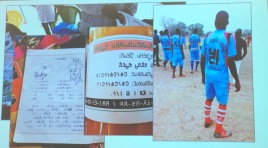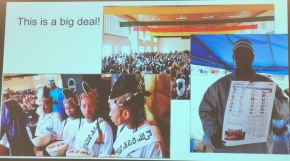
Some days, there are too many overlapping events. On Thursday, 15 February 2018, there were at least three:
- the TypeThursday love of letterforms gathering in San Francisco (@TypeThursdaySF) that I often attend—there are also monthly gatherings in Chicago (@TypeThursdayCHI), London (@TypeThursdayLON), Los Angeles (@TypeThursdayLA), New York (@TypeThursdayNYC), Philadelphia (@TypeThursdayPHL), and Seattle (@TypeThursdaySEA);
- the IMUG (The International Multilingual User Group, @i18n_mug #IMUG408) talk on ADLaM—An African Alphabet Adventure with Craig Cornelius, joined by Ibrahima & Abdoulaye Barry (creators of the script) via video chat; and
- the Society of Composers & Lyricists (@The_SCL) seminar on Scoring Documentaries: Notes on Non-fiction live stream (~3-hour video). Panel consisted of Jeff Beal (@jbealmusic), Joel Goodman (@jgoodmanmusic), Catherine Grealish (@CathGrealish), Gary Lionelli, and Miriam Cutler (@MiriamCutler1), moderated by Fletcher Beasley (@fictionalradio).
 I ended up at the IMUG presentation on the ADLaM script. Craig Cornelius gave an introduction to the script and its history with stories of how he got involved plus his recent attendance at the 3rd ADLaM Conference in Mamou, Guinea, 5–8 January 2018. Over 800 people attended the conference from the Democratic Republic of the Congo to Mauritania and Chad to Liberia, plus Angola, Kuwait, Belgium, Spain, USA, and beyond. After Craig’s presentation, Ibrahima & Abdoulaye Barry (creators of the ADLaM script) joined in via video chat for the question and answer part of the evening. They started creating the script in 1989 when they were ages 10 and 14.
I ended up at the IMUG presentation on the ADLaM script. Craig Cornelius gave an introduction to the script and its history with stories of how he got involved plus his recent attendance at the 3rd ADLaM Conference in Mamou, Guinea, 5–8 January 2018. Over 800 people attended the conference from the Democratic Republic of the Congo to Mauritania and Chad to Liberia, plus Angola, Kuwait, Belgium, Spain, USA, and beyond. After Craig’s presentation, Ibrahima & Abdoulaye Barry (creators of the ADLaM script) joined in via video chat for the question and answer part of the evening. They started creating the script in 1989 when they were ages 10 and 14.
The presentation and discussion were inspirational. The ADLaM script seems effective in teaching how to read and write Fulani/Pulaar and has potential to improve literacy for millions. Its use has spread across Africa and seems to be gaining momentum among the Fulbe people. The script can also be used for other African languages. One of the advantages over Latin and Arabic script (both currently used to write various African languages) is that ADLaM represents some of the sounds unique to those languages with less ambiguity. At some point, I may design some ADLaM typefaces.
Some of the current challenges:
- convert existing ADLaM writing from the old encodings to the new Unicode encodings.
- Adlam Script Testing tool by Craig Cornelius (source code).
- technology integration of ADLaM script, keyboard, and fonts support.
- Operating system support: Google has started support. I don’t know Apple’s, Microsoft’s, nor Unix systems plans.
- Support in apps and web apps, especially when base OS doesn’t yet support the script.
- e.g., see the Adlam Kiimirgal (calculator for Android) and CalConversion (a multi-script calculator & unit converter that supports Latin, Arabic, N’Ko, and ADLaM numerals) apps developed by JamraPatel (@JamraPatel).
- design more fonts and styles.
I suspect that eventually Richard Ishida (@r12a) will add ADLaM to his tools for various scripts, like he has for N’Ko (script summary, character picker, and character notes) and many other scripts. View the ADLaM Unicode block in his UniView tool.
Adlam availability from Google:
- Android 8.0 & standard Chromebook release Q4 2017+ include Noto Sans Adlam font.
- GBoard Adlam keyboard available as of December 2017.
- Supported in Google Input tools extension for any Chrome browser window (any computer) and Chromebooks.
It was fun to see familiar names as part of the story, some unexpectedly, like mention of Stephen Rapp helping connect the Barry brothers to the Unicode Consortium (@unicode) by way of Deborah Anderson of UC Berkeley’s Script Encoding Initiative at the 2013 Lettering Arts/Calligraphy Conference in Colorado Springs, Colorado, USA. Coincidentally, on the same day of this ADLaM talk I attended on 15 February 2018, Deborah Anderson was presenting a Sawyer Seminar on Preserving the World’s Languages and Cultures (through character encoding) at the Institute for Comparative Literature and Society at Columbia University (@ICLSColumbia).
Craig Cornelius also has worked with the Cherokee Nation on their script. @NPR talked about some of his work in Gmail Sends Message in Cherokee (20 November 2012). Craig also presented some of his work in Indigenous languages and technology—Challenges, standards, & tools for small language communities at the United Nations International Expert Group Meeting on Indigenous Languages (@UN4Indigenous), 19–21 January 2016.
Read and watch more about ADLaM and other African scripts (plus one in Sri Lanka):
- IMUG (@i18n_mug) talk on ADLaM—An African Alphabet Adventure (photos, video [soon or via talk link]), 15 February 2018. Hosted by the Google Internationalization Engineering group.
- @TheAtlantic article The Alphabet That Will Save a People From Disappearing by Kaveh Waddell (@kavehwaddell), 16 November 2016.
- Though the title is a little misleading, the article is interesting.
- Randall M. Hasson’s (@RandallHasson) three-part blog post series on The ADLaM Story — How Alphabet Changes Culture (part one, two, and three), April 2014.
- Talks at Google: The ADLaM Story: The Alphabet for Our People and Our Language (~1-hour video), 14 March 2017. That talk helped Google engineers attending realize the importance of having basic support for ADLaM.
- Thomas Phinney (@ThomasPhinney) talked about the Amma script (Sri Lanka) created in 2013 and ADLaM (Africa) at the 2015 Granshan Conference in his talk New Writing Systems: Amma & Adlam (29-minute video of the talk in that post). He also wrote a column about the scripts in @CommArts titled Finding a Common Language.
- The next Granshan Conference (@granshanconf) will be in San José and San Francisco, California, USA, 24–29 July 2018, with an Armenian script day in Los Angeles, 23 July 2018.
- Mark Jamra and Neil Patel (@JamraPatel) have given presentations about their work on African scripts (N’Ko, Ge’ez, Vai, ADLaM, Tifinagh) at TypeCon (@typecon, @typesociety) and Stanford’s Face/Interface conference 2017 (conference presentation slides).
IMUG related links:
- IMUG events, jobs (jobs board, @i18n_mug, @UweMuegge), #IMUG408
- Next IMUG presentation, Thursday, 15 March 2018, 6:30–9pm at Adobe, San Jose, California, USA:
- Ten Mincho: To Boldly Go Where No Japanese Font Has Gone Before by Dr. Ken Lunde (@ken_lunde) about how the Adobe Originals (@adobetype) Japanese 貂明朝 (Ten Mincho) typeface and its fonts were developed.
- Read Ken’s @CJKType blog post about this typeface designed by Ryoko Nishizuka (@ryon106) and
- the official announcement by @typekit, written by Sally Kerrigan (@draftwerk).
—Jeff Kellem (@composerjk / @slantedhall)
1403 Vintage Mono Pro typeface specimen
